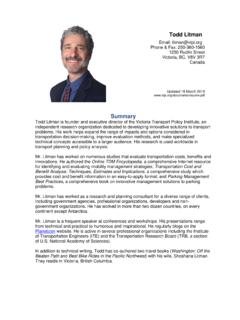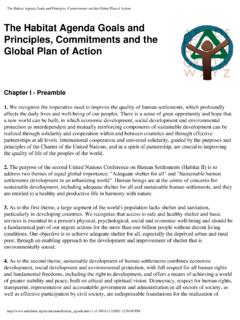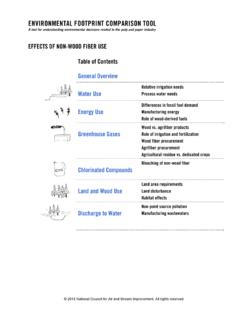Transcription of Human Settlement Development Information and …
1 UNESCO EOLSSSAMPLE CHAPTERSPRINCIPLES OF SUSTAINABLE Development - Vol. III Human Settlement Development Information and knowledge - Dimitri Devuyst Encyclopedia of Life Support Systems (EOLSS) Human Settlement Development Information AND knowledge Dimitri Devuyst Vrije Universiteit Brussel, Belgium Keywords: Human settlements, sustainable Development , child labor, land use Contents 1. Introduction 2. International Attention for Human Settlements International Conferences on Human Settlements The Istanbul Declaration The Habitat Agenda The United Nations Conference on Environment and Development 3.
2 Sustainable Human Settlements Development 4. Social Aspects of Sustainable Human Settlements Health Related Problems Environmental Racism and Environmental Justice Child Labor Eviction from Squatter Settlements Urban Violence Food Security Migration 5. Economic Aspects of Sustainable Human Settlements 6. Environmental Aspects of Sustainable Human Settlements Land Use Energy Use The Built-Up Areas and the Green and Blue Spaces Other Environmental Problems 7. Community Development and Capacity Building for Sustainable Human Settlements 8. Planning, Decision-Making and Managing Human Settlements 9.
3 Conclusions Glossary Bibliography Biographical Sketch Summary The Human population on the Earth is growing, resulting in the expansion of Human settlements and an increase in a wide range of problems, mostly in the booming urban areas. The United Nations has played an important role in attracting international attention to the problems of Human settlements with the organization of conferences in Vancouver and Istanbul. The latest conference in 1996 resulted in the Istanbul Declaration and the Habitat Agenda. Providing adequate shelter for all and working towards sustainable Human settlements Development were the main themes of the conference.
4 In this article a distinction is made between issues in less developed UNESCO EOLSSSAMPLE CHAPTERSPRINCIPLES OF SUSTAINABLE Development - Vol. III Human Settlement Development Information and knowledge - Dimitri Devuyst Encyclopedia of Life Support Systems (EOLSS) countries and more industrialized regions. Cities in developing regions need to look into the sustainable provision of basic Human needs, such as decent housing, water and energy supply, sanitation systems, education, and health care services. Local authorities in industrial areas have to focus on the reduction of energy and material consumption, reducing the need to travel by car, and stimulating inhabitants to lead a more sustainable lifestyle.
5 Social, economic, and environmental aspects of more sustainable Human settlements are discussed, and examples on how to solve existing problems are introduced. The eradication of poverty, exclusion and inequality is considered very important in making Human settlements more sustainable. Planning and construction strategies for cities which integrate natural processes, and which try to function within the limits of the natural ecosystem are presented. Involving the local population in developing the neighborhood in which they live, empowering the community, and developing an economy that benefits the local people is considered part of a more sustainable future.
6 While developing Human settlements there is a constant need to ask the question does the Development benefit the local people, ameliorate their quality of life and improve the local environment? 1. Introduction The earliest Human societies consisted of hunters and gatherers. These are small groups or tribes with fixed territories, migrating regularly around them. Not many hunter and gatherer cultures remain today. About twenty thousand years ago, pastoral societies and agrarian societies emerged. Pastoral societies, relying on domesticated livestock, move across large distances, while agrarian societies grow crops, settle in a certain place, and form the first permanent Human settlements.
7 From about 6000 BC, large societies emerge in which cities develop, although society is still largely based on agriculture. Large-scale urbanization is a much more recent phenomenon, linked to the industrialization of society. The Industrial Revolution originated in eighteenth century England, and resulted in the concentration of many Human activities in the city. This discussion on Human settlements is mainly a discussion of urban issues today, because global and urban population growth rates will bring about an important expansion of cities in the coming decades.
8 By the year 2000, the urban population has reached approximately billion people and is expected to grow to 5 billion by 2025; some 61% of the world population will then live in urban areas. Estimates show that by 2015, the world will contain around 560 cities with more than one million people. Urban growth is also demonstrated by the increase of the number of megacities, which are defined as cities with a population exceeding 8 million. In 1950, New York and London were the world s only megacities. By 1990, there were 21 megacities, 16 of them in developing countries.
9 In 2015, there are expected to be 33 megacities, 27 in the developing world. However, these figures need to be put in their proper context. Only a small percentage of the South s total population is found in megacities, and most developing countries have no megacities. Urbanization is closely linked to economic growth. In general, the higher the per capita income of a country, the higher the level of urbanization. Low-income countries are also among the least urbanized. Most of the urban population in the South is found in urban centers with less than one million inhabitants.
10 In other UNESCO EOLSSSAMPLE CHAPTERSPRINCIPLES OF SUSTAINABLE Development - Vol. III Human Settlement Development Information and knowledge - Dimitri Devuyst Encyclopedia of Life Support Systems (EOLSS) words, the focus should not only be on managing the problems of giant metropolises, but also on looking into all kinds of Human settlements. Human settlements are currently called cities, towns, or villages, and a distinction is made between urban and rural settlements. Is a given Settlement a city or not? What is or is not a city is relative, and must be considered in the context of any given society.


















